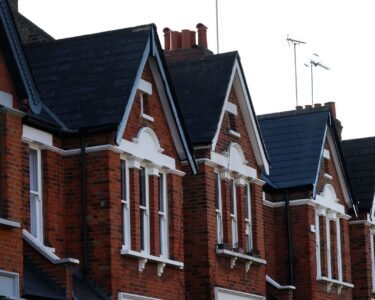Buy-to-let landlords are being hit by higher interest rates, higher costs and a less friendly tax regime.
Many have seen their costs spiral, meaning that landlords will be watching the current recent falls in mortgage rates with just as much interest as homeowners and first-time buyers.
There are more than 2 million buy-to-let properties that have a mortgage attached, according to UK Finance data.
An estimated 230,000 of these have fixed-rate mortgage deals that are due to end this year.
While the residential rates aimed at home buyers and homeowners have hogged the headlines, buy-to-let rates have also moved downwards.
We look at what landlords need to consider when taking a new mortgage, and list some of the best deals available.

Financial shock: Many landlords who own with a mortgage will be seeing their profits cut down by higher mortgage rates
How cheap are buy-to-let mortgage rates?
Many landlords who own with a mortgage will be seeing their profits decimated by higher mortgage rates, having been lulled into a false sense of security by the ultra-cheap finance available in recent years.
Mortgaged buy-to-let investors often use interest-only mortgages to ensure higher cashflow. But when paying interest-only, if the mortgage rate doubles or triples, so do the monthly payments.
The average two-year fixed rate buy-to-let mortgage is now at 5.47 per cent while the average five-year buy-to-let mortgage is 5.48 per cent.
It means a typical landlord requiring a £200,000 interest-only mortgage on a two-year fix will need to pay £912 a month in mortgage costs if buying or remortgaging at the moment.
Add that to the cost of periods where the property is empty, repairs, maintenance, letting agent fees, compliance checks, insurance and service charges and it shows how reliant many landlords will be on rents rising in order to turn a profit.
Many of the landlords who are now remortgaging had become accustomed to rock bottom rates.
For example, someone who purchased two years ago will have enjoyed an average two-year fixed rates were 2.38 per cent.
It means on a £200,000 mortgage they would have factored in monthly mortgage costs of around £397 – not the £912 they are likely to face when remortgaging today.
That said, mortgage rates have been gradually falling since summer last year meaning the situation is not as dire as it was.
The average two-year fixed rate for buy-to-let reached a high of 6.97 per cent in July.
On a £200,000 interest only mortgage that’s the difference between having to pay £1,162 a month and £912 a month.
Some landlords will do much better than the market average, by using a comparison site or using a whole-of-market mortgage broker to find them a cheaper rate. This will depend to some extent on how much equity they have in the property.
A word of warning here: many of the lowest buy-to-let mortgage rates come with staggeringly high fees. These can be as high as 7 per cent of the total mortgage amount in some cases.
While the lowest two-year fixed rate is currently 3.54 per cent with the Mortgage Works, it comes with a 3 per cent product fee. On a £200,000 mortgage that will mean paying an extra £6,000 upfront or adding an extra £6,000 to the mortgage.
This means it’s essential to look at the overall cost of the mortgage and factor in both the fees and the interest rate.
To secure the cheapest deal landlords will also typically need to be buying with at least a 40 per ent deposit or be remortgaging with at least 40 per cent equity in the property.
Howard Levy, a buy-to-let specialist at mortgage broker SPF Private Clients says: ‘Many landlords have seen rents rise significantly, but not to the same degree as mortgage rates have increased.
‘Just as with the residential market, headline buy-to-let fixed rates have been falling in recent months.
‘However, landlords should beware that the ‘best buy’ buy-to-let deals often come with large fees.’
How to assess where mortgage rates are heading?
Lenders tend to price their fixed-rate mortgages based on future market expectations for the Bank of England’s base rate.
In recent months, forecasts for where the base rate would eventually peak have fallen from a high of 6.5 per cent in the summer to 5.25 per cent.
The base rate has been held at the same level of 5.25 per cent since August 2023 and analysts believe the Bank will cut it multiple times in 2024.
Following the latest MPC meeting at the start of this month investors are price in roughly 100bps of cuts – leaving base rate at 4.25 per cent in by the end of 2024.
Market expectations are reflected in swap rates – financial market rates which anticipate where interest rates will be in two and five years’ time, when fixed mortgages lent today will expire.
Five-year swaps are currently at 3.78 per cent and two-year swaps are at 4.36 per cent – both trending well below the current base rate of 5.25 per cent.
Only as recently as July, five-year swaps were above 5 per cent. Similarly, the two-year swaps were coming in around 6 per cent.
That said, the direction of swap rates has slightly changed over the past couple of weeks.
They are slightly up when compared to the start of the year, five-year swaps were 3.4 per cent and two-year swaps were 4.04 per cent.
You can check best buy tables and the best mortgage rates for your circumstances with our mortgage finder powered by London & Country – and figure out what you’ll actually be paying by using our new and improved mortgage calculator.
Should you fix or take a tracker?
The case in favour of fixing for five years
Five-year fixes currently offer the cheapest deals, and having certainty over monthly payments for the next five years may also appeal to some borrowers, given how much interest rates have shot up over the past 24 months.
And fixing for five years, rather than two years, can sometimes enable landlords to borrow more.
This is because lenders tend to impose more generous affordability tests.
Howard Levy at mortgage broker SPF Private Clients, says: ‘Typically, a five-year fix will be stressed at a lower rate than a two-year fix.
‘Given the existing borrowing, higher rates and higher interest cover ratios, it may not be possible to raise the level of [funds] required without fixing for five-years in some cases.’
Paying higher product fees, achieving higher rental incomes, or not being classed as a higher-rate taxpayer are also ways to boost maximum borrowing levels.
The case in favour of fixing for two years
Many of those opting for a two-year fix will be doing so because they think interest rates will fall over the next couple of years.
They are banking on the expectation that once inflation subsides, the base rate – and then mortgage rates – will come down, allowing them to fix at a cheaper rate.
Nicholas Mendes of mortgage broker John Charcol says: ‘It would be worthwhile to consider the short-term pain, rather than be tempted by some of the five-year fixed rates currently on offer.
‘If rates fall as predicted you don’t want to be tied into a higher rate for longer than you need to be.
‘It may also be worth considering a three-year fix if you want stability for slightly longer than two years, but to avoid being tied in for five.’
Howard Levy of SPF Private Clients argues that many landlords are avoiding the stress testing required for shorter fixes by sticking with their current lender when they refinance.
He adds: ‘There is a greater tendency for two-year fixes to be taken as product transfers or internal pound-for-pound remortgages as these are typically not stressed as long as the landlord’s payments are up to date.’
‘Many of these landlords are taking out this shorter deals with a view to booking a five-year fix later down the line, perhaps when pricing is more palatable.’
The case in favour of a tracker mortgage
Those that are confident of rates falling faster and further than expected may even be trying their luck with a tracker mortgage.
Trackers follow the Bank of England’s base rate, plus or minus a set percentage.
For example, someone could be paying base rate plus 0.75 per cent on top with a tracker. With the base rate at 5.25 per cent, they’d pay 6 per cent at present.
But if the base rate was cut to 4.5 per cent, for example, their rate would fall to 5.25 per cent.
The main benefit of tracker deals is that they typically don’t come with early repayment charges.
This means if mortgage rates fell over the coming year, someone with a tracker deal could switch to a cheaper fixed deal as and when they liked.
On the flip side, if the base rate stays the same or even rises this year, it could end up becoming an expensive gamble.
Gamble: At present, borrowers opting for a tracker deal will likely pay more than if they fix. The hope is that interest rates will fall.
‘If I could afford to be wrong and could cope with fluctuations in rates, then a base-rate tracker with no early repayment charges could be worth considering and monitoring the market closely,’ adds Mark Harris, chief executive of mortgage broker SPF Private Clients.
‘Should fixed rates come down, you could then move over to a new rate without having to pay a penalty.
‘As always, it is worth using a whole-of-market broker to ensure you get the right advice and deal for your circumstances.’
Howard Levy adds: ‘With a tracker, of course, the landlord is exposed to potential rate fluctuations.
‘Expectations are for base rate to fall this year but there is always an element of a gamble when taking a variable rate.
‘Given that rents are typically fixed for six or 12 months, this exposes the landlord to increased costs should mortgage payments rise.’
What are the best buy-to-let rates?
Below, we highlight some of the best deals available to buy-to-let landlords.
Buy-to-let mortgage rates often come with product fees as high as 10 per cent of the loan. The below are the deals with the cheapest overall annual costs when both the initial rate and fees are taken into account.
This is based on the property value being £200,000. The mortgages sourced are available for purchases, and remortgage deals may be slightly different.
40% deposit mortgages
Five-year fixed rate mortgages
BM Solutions has a five-year fixed rate at 4.34 per cent with a £100 fee at 65 per cent loan to value.
HSBC has a five-year fixed rate at 4.38 per cent with £0 fees at 60 per cent loan to value.
Two-year fixed rate mortgages
HSBC has a two-year fixed product at 4.83 per cent with zero fee at 60 per cent loan to value.
Halifax has a two-year fixed rate at 5.02 per cent with £100 fees at 60 per cent loan to value.
25% deposit mortgages
Five-year fixed rate mortgages
HSBC has a five-year fixed rate at 4.48 per cent with a £0 fee at 75 per cent loan to value.
The Mortgage Works has a five-year fixed rate at 4.34 per cent with £1,775 fees at 75 per cent loan to value.
Two-year fixed rate mortgages
HSBC has a five-year fixed rate at 4.93 per cent with a £0 fee at 75 per cent loan to value.
BM Solutions has a five-year fixed rate at 4.58 per cent with £1,599 fees at 75 per cent loan to value.
Best two-year tracker without early repayment charges
40% deposit
TSB has a two-year tracker at 5.74 per cent with a £995 fee at 60 per cent loan to value. This is base rate (5.25 per cent) plus 0.49 per cent.
HSBC has a two-year tracker rate at 6.34 per cent with £0 fees at 60 per cent loan to value. This is base rate plus 0.65 per cent.
25% deposit
Skipton Building Society has a two-year tracker rate at 5.94 per cent with a £995 fee at 75 per cent loan to value. This is base rate plus 0.69 per cent.
HSBC has a two-year tracker rate at 6.44 per cent with no fees at 75 per cent loan to value. This is base rate plus 1.19 per cent.
Some links in this article may be affiliate links. If you click on them we may earn a small commission. That helps us fund This Is Money, and keep it free to use. We do not write articles to promote products. We do not allow any commercial relationship to affect our editorial independence.





